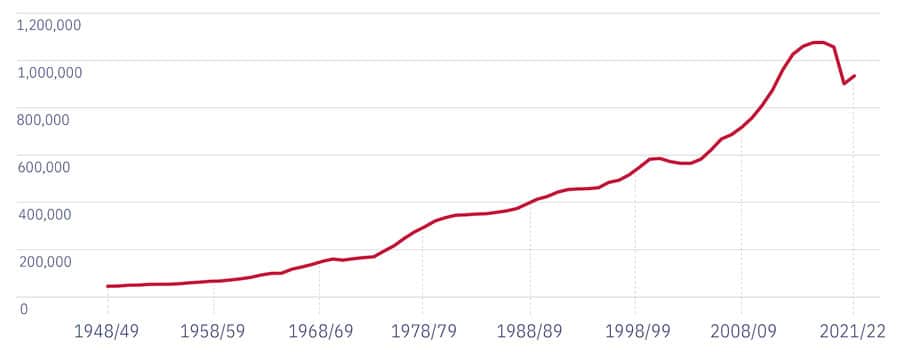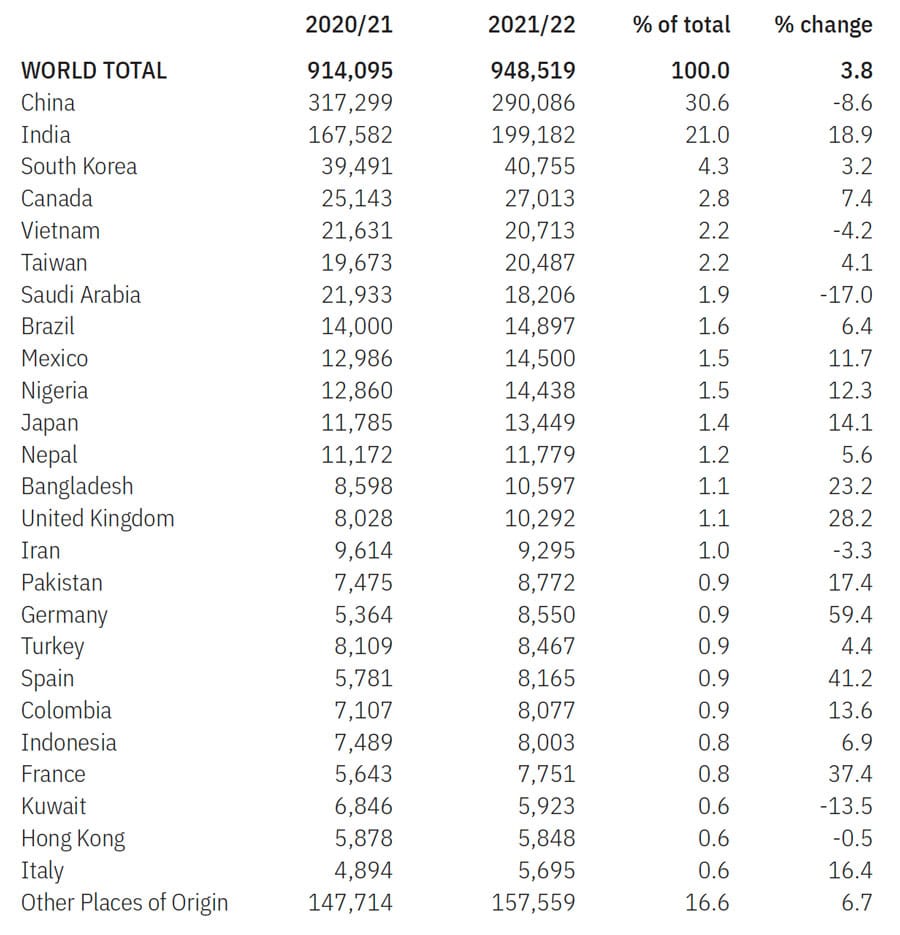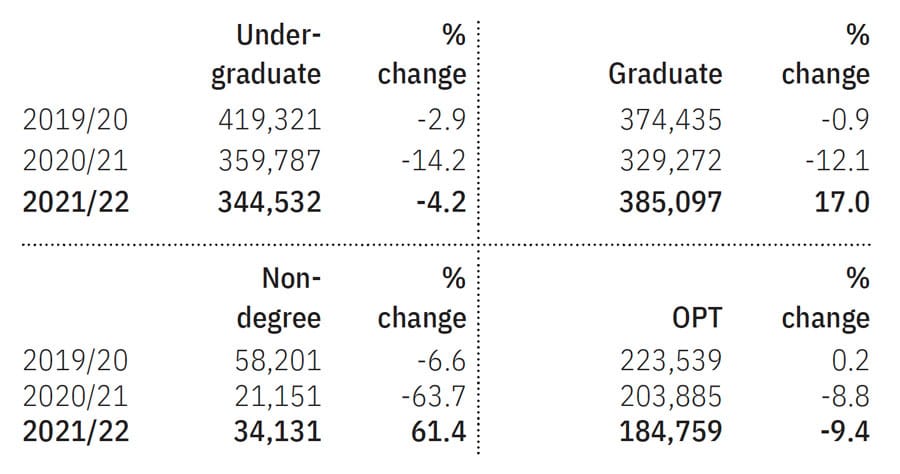Foreign enrolment in US rebounded in 2021/22 and is approaching pre-pandemic levels
- The latest international student census in the US shows that foreign enrolment in the US grew by 4% in 2021/22 year-over-year – a striking contrast to the 15% decline recorded the previous year
- New international enrolments surged by 80% over 2020/21 levels – again, a sharp improvement on the 46% decline in student commencements reported last year
- International demand shifted noticeably to US graduate programmes in 2021/22, with more graduate students than undergraduates at US colleges for the first time in a decade
- A Fall Snapshot survey conducted by the IIE and nine partner higher education institutions suggests that international enrolment growth in the US is on track to be even more substantial in 2022/23
- US educators are leveraging the power of current international students in their overseas recruitment strategies – more than any other form of outreach
International student enrolments in the US grew by 4% in 2021/22 compared with the previous year according to data from the just-released Open Doors® 2022 Report on International Educational Exchange from the International Institute of Education (IIE). This growth was driven by thousands of new international students who enrolled with US higher education institutions for the first time in 2021/22: there were 80% more new students than in 2020/21, representing a return to pre-pandemic levels of new students. Fully 90% of enrolled students were learning in-person on US campuses.
The 2021/22 data paint a very different picture than was the case the last time IIE presented its Open Doors findings. In 2020/21, there had been a 46% decline in new international student enrolments and a 15% decline in total enrolments.

Of the rebound, Lee Satterfield, assistant secretary of state for educational and cultural affairs, said: “We are thrilled to see international student numbers on the rise, and to see the United States maintain its global leadership as the top destination of choice for international students.”
The total number of international students in US higher education in 2021/22 was 948,519, which is 4.7% of the total student population in US colleges and universities.
This remains roughly 12% below the pre-pandemic enrolment of 1,075,495 international students in 2019/20. Foreign enrolment in the US had declined marginally that year, marking the first such decline in overall enrolment since the mid-2000s.
The broader context for that 2019/20 enrolment benchmark is that the 2019/20 decrease followed two years of only marginal growth in the US, which was largely bolstered by increasing participation in Optional Practical Training (OPT), a programme that allows international students to remain in the US to work for up to three years after graduation.
Double-digit growth from many markets
China and India remain the top two senders of students for US institutions, accounting for just over half (52%) of international enrolments. China continues to send fewer students than in the past (-9% year-over-year for a total of 290,086), while India is sending significantly more students (+19% for a total of 199,182).
The top international markets for US colleges and universities are shown in the following chart. Many of these markets sent more students in 2021/22 than in 2020/21. The top 10 markets are overall the same as the previous year, but Vietnam and Taiwan are now sending more students than Saudi Arabia. Saudi Arabia had been the US’s #3 sender of students in 2015/16 but declines since then – precipitated by the end of the King Abdullah Scholarship Program – now place Saudi Arabia in seventh position. Nigeria, meanwhile, has grown by 35% since 2015/16 – higher even than the increase from India in that same period (21%).

Overall, if we look at the top 20 markets for the US in 2021/22, there was double-digit growth in student numbers from the following countries:
- India
- Mexico
- Nigeria
- Japan
- Bangladesh
- UK
- Pakistan
- Germany
- Spain
- Colombia
- France
- Italy
“The incredible rebound we have seen in international student mobility demonstrates the United States’ and its higher education institutions’ unwavering commitment to welcoming students from around the world,” said IIE CEO Allan E. Goodman.
The contribution of international students to the US economy was US$32 billion in 2021, according to the US Department of Commerce.
North America receiving many more European students
European countries were among the fastest growing markets for US educators in 2021/22. Germany, Spain, and France were up by 59%, 41%, and 37%, respectively, over the previous year. This is also a trend in Canada; for example, France and Germany sent 46% and 240% more students, respectively, to Canada in 2021. The US and Canada appear to be benefitting from the UK's declining share of European enrolments since Brexit.
Looking across levels
Undergraduate international enrolments in the US have not yet returned to a growth trajectory; they fell by -4.2% in 2021/22 after a -14.2% decline the previous year. By contrast, graduate enrolments increased by 17% year-over-year to total 385,097 enrolments – higher than pre-pandemic levels. Non-degree enrolments grew by 61.4% – a big gain – but non-degree enrolments are still significantly down from levels in 2019/20. Optional Practical Training (OPT) enrolments declined by -9.4%. As we’ll discuss soon, however, OPT enrolments are rebounding in the 2022/23 academic year.
“These increases, particularly at the master’s level, were likely due to pent up demand from the previous year,” added Dr Mirka Martel, Head of Research, Evaluation and Learning at IIE. “The total number of graduate students at 385,097 was higher than the pre-pandemic total. There were more graduate students at US colleges and universities than undergraduates for the first time in a decade. Undergraduate enrolments continue to decline at 4%. Though it is important to note that first year bachelors, or freshman, totals increased by 20%.”

Big jump in STEM enrolments
Overall, Math and Computer Science, Engineering, and Business and Management programmes enrol more than half of all international students in the US. Math and Computer programmes are ever more popular, with year-over-year growth of 10% in 2021/22. By contrast, international enrolments in Engineering programmes fell by 1.3% and Business and Management enrolments were virtually flat (+1%).
Further growth on the horizon
IIE also announced the results of its Fall 2022 Snapshot survey today. These are based on responses from over 630 US higher education institutions accounting for 52% of all international students, and they reflect current enrolment patterns as of fall 2022 (for the 2022/23 academic year).
Across the 630 responding institutions to the survey, international enrolments for the 2022/23 academic year increased by 9% over 2021/22. This 9% growth (which follows 4% growth in 2021/22) represents the trend for the 630 institutions surveyed; a fuller picture of enrolment trends will not be available till the next Open Doors Report in fall 2023. Still, the Fall Snapshot findings suggest that international enrolments in the US will continue to increase this year.
Fall Snapshot findings indicate that participating US institutions welcomed 7% more new international students and that there were 6% more students participating in OPT this fall. Almost two-thirds (63%) of institutions reported an increase in new student enrolments, and 87% said that financial support for their student recruitment efforts is the same or higher as in previous years.
It’s also interesting to look at the international recruitment techniques being used currently by US educators. The top method for reaching and influencing prospective international students is “current international students” (e.g., student ambassadors) – 64% of institutions are leveraging this opportunity. After that, “online recruitment events” and “international partnerships” follow at 53% each.
For additional background, please see:
















